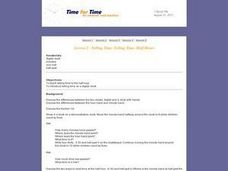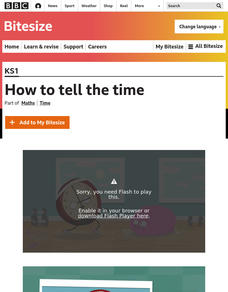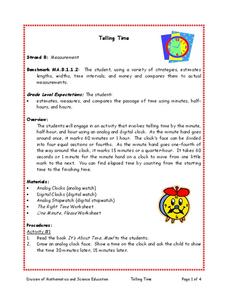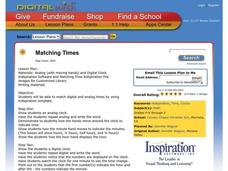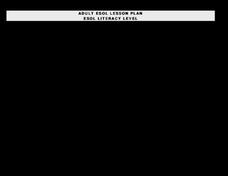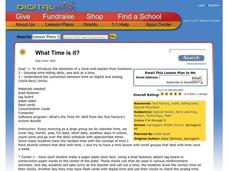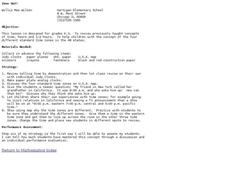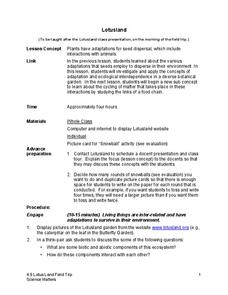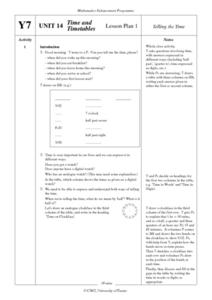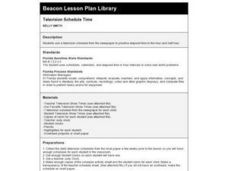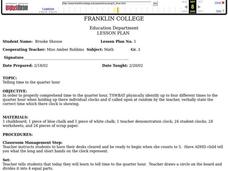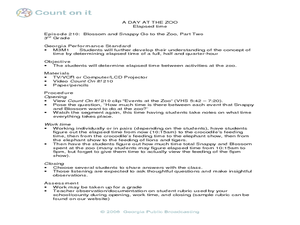Time for Time
Telling Time: Telling Time: Half Hours
The whole class discusses the differences between the two clocks: digital and a clock with hands. They discuss the differences between the hour hand and minute hand. Students are taught telling time to the half hour. They are introduced...
Curated OER
Rock Around the Clock Math
An engaging and fun lesson on telling time is here for you. In it, young time-tellers listen to the song, "Rock Around the Clock," then use Judy Clocks to practice telling time to the hour and half hour. Finally, using paper plates, each...
Curated OER
Half Hour Time
In this math worksheet, students fill in the time for half hour intervals. They use the pictures of clocks to fill in the hour and second hands.
Curated OER
Telling Time
First graders play a fun game while learning to tell time. This BBC site is well designed. They enjoy it while learning a lot. Playing in pairs would be lots of fun.
Curated OER
Telling Time
Students estimate, measure, and compare the passage of time using minutes, half hours, and hours. They read the book 'It's About Time, Max!' with the teacher and draw an analog clock face. They show the time and 30 minutes later, 15...
Curated OER
Matching Times
Study digital and analog times on a clock with learners. They will use the Kidspiration template to create a digital and analog time display on the computer. They also display the correct times on both analog and digital clocks when the...
Curated OER
ESOL: Time and Money
Students study the parts of an analog and digital clock. They create paper clocks to identify telling time to the hour, half-hour, and quarter past and quarter after. They practice tellng time in pairs.
Curated OER
What Time is it?
Students participate in three centers focused on developing time-telling skills. In this time lesson, students create their own paper plate clock face, play "Time Concentration" using times on the hour and half hour, as well as, practice...
Space Awareness
Oceans as a Heat Reservoir
Oceans absorb half of the carbon dioxide and 80 percent of the greenhouse gases released into the atmosphere. Scholars learn how and why the oceans store heat more effectively than land and how they help mitigate global warming. Pupils...
Curated OER
Zone Out!
Students review telling time to the hour and half hour on an analog clock. For this time lesson, the students learn how to determine the time in each of the 4 standard time zones.
Curated OER
Clocks and Time
Second graders observe and demonstrate how to tell and write time. They discuss different ways and things that tell time, then listen to a teacher-led lecture about the hands on a clock. Students complete a worksheet along with the...
Curated OER
Telling Time
Young learners participate in activities which help them understand analog clocks, and the vocabulary of telling time. They examine the values of the intervals of minutes and hours by making a human clock.
Indiana University
World Literature: "One Evening in the Rainy Season" Shi Zhecun
Did you know that modern Chinese literature “grew from the psychoanalytical theory of Sigmund Freud”? Designed for a world literature class, seniors are introduced to “One Evening in the Rainy Season,” Shi Zhecun’s stream of...
Curated OER
Time Foldable
First graders listen to and discuss the book, The Time Song. In this math lesson, 1st graders discover what they can do in a second, a minute, and a hour. Additionally students create a flap book to display time equivalencies.
Science Matters
Lotusland
It's time for a field trip! Scholars take their new-found knowledge of adaptations and seed dispersal on a field trip to a local botanical garden. They gain an up-close look at how ecological interdependence works in a distinct...
Curated OER
Time for a Plumber!
Fourth graders compare amounts of time in seconds, minutes and hours. In this multiplying and comparing time lesson, 4th graders problem solve a plumbing problem scenario to find which amount of time is the least. Students...
Curated OER
Seeing the Image in Imagery: A Lesson Plan Using Film
In our increasingly visual society, it is often difficult for some readers to create a mental picture of a picture created only with words. An image-rich text like F. Scott Fitzgerald's The Great Gatsby can therefore, present a real...
Curated OER
Time and Timetables
Students, after answering a variety of questions involving time expressed in different ways, draw a table to illustrate time in words as well as digits. In connection, they observe time on analogue watches and clock faces along with what...
Alabama Learning Exchange
Mr. Crocodile's Busy Day
Demonstrate how to read analog and digital clocks to the hour in this time measurement lesson. Read the book What Time is it Mr. Crocodile? and use Mr. Crocodile's schedule to practice telling time. They work in cooperative groups to...
PwC Financial Literacy
Saving and Investing: Investing for the Future
A fine lesson on saving and investing is here for you and your middle schoolers. In it, learners explore the values of time and money, and discover how small amounts of money invested over time can grow into a large "pot of gold." They...
Curated OER
Television Schedule Time
Students consider the concept of elapsed time by examining television schedules. They list five television shows and highlight them in a newspaper, marking down the beginning and ending time of each show. They use clocks to figure out...
Curated OER
Clock
Basic time-telling practice is the focus here.Youngsters discuss the different clocks they have in their homes, and practice filling in the time by adding the minute and hour hands to blank clock faces.
Curated OER
Telling Time
Third graders use a clock to physically identify time at the quarter hour. As a class, they are randomly called on and expected to hold up their clock with the correct time. They complete a worksheet and answer questions to complete...
Curated OER
A Day at the Zoo - Elapsed Time
Third graders discover the concept of elapsed time. In this time instructional activity, 3rd graders watch a video which shows zoo feedings. They work in groups to find the elapsed time between feedings.


